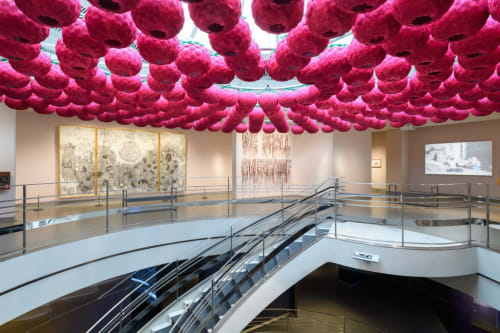A resplendent display of 272 fuchsia-colored paper lotus lanterns adorns the light-filled oculus on The Rubin Museum of Art’s top floor. The sweeping circular installation, “Lotus: Zone of Zero” (2019) by Kimsooja, is among the more striking of the works by 10 international artists selected by guest curator Sara Raza for the exhibition Clapping with Stones: Art and Acts of Resistance.
The artists in the show come from everywhere and live, mostly, elsewhere. Kimsooja was born in South Korea. Shahpour Pouyan, in Iran. Nari Ward, in Jamaica. Pallavi Paul, in India. Hank Willis Thomas, in the United States. Lida Abdul, in Afghanistan. Nadia Kaabi-Linke, in Tunisia. Naiza Khan, in Pakistan. Kader Attia, in France. Ibrahim Qureshi, in Kenya.
The destruction of the Buddhas bespeaks the way the effects of imperialism reproduce themselves in an indigenous population, in even more nefarious ways. “Burn the Diaries” (2014-2019) by the Indian artist, Pallavi Paul, provides another account of information that is destroyed in order to erase inconvenient truths. While conducting research in London, Paul came across the personnel file of Noor Inayat Khan, a World War II female British spy of Indian and American descent, in the official archives.
Parts of the original file, apparently laced with contradictions and omissions, is rendered on a monumental silk scroll, along with passages in Morse code. Seemingly raising questions about the nature of verisimilitude and the withholding of truth, the use of silk in Paul’s work is particularly interesting, in that silk and other fabrics were evidently used as espionage tools to encode messages during the war.

